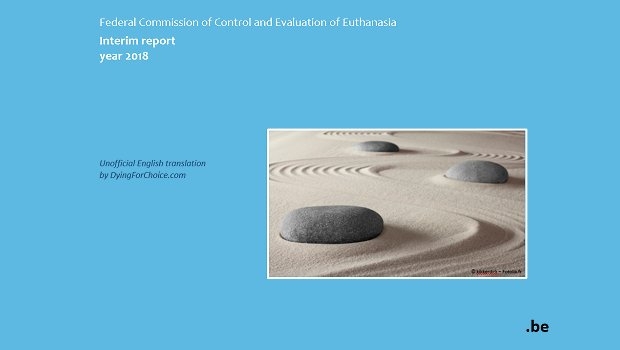Belgian euthanasia report for 2018 released

Belgium's Federal Commission for Control and Evaluation of Euthanasia has released a summary report of cases for the 2018 calendar year. Numbers have stabilised, with a tiny 1.8% increase on the figures for the previous year. All cases were found to have met the essential conditions of the Euthanasia Act. Below is an English translation of the report.
Belgium Euthanasia - Figures for the year 2018
By Jan Eyckmans
Posted on 28/02/2019
These figures relate to the registration documents for euthanasia carried out between 1 January 2018 and 31 December 2018 examined by the Commission. A more detailed analysis of euthanasia reported in 2018 will be made in the next biennial report of the Commission (gathering data for 2018 and 2019).
The number of reports received during this period was 2357. The majority were written in Dutch, concerned patients aged 60 to 89 years and slightly more women. Most often, euthanasia took place at home.
The main conditions causing the euthanasia claims were either cancers or a combination of several conditions (polypathologies) that were not likely to improve and that caused more and more serious disabilities up to organ failure. Death of patients was usually expected in the near future. Patients whose death is clearly not expected in the short term suffered mostly from polypathologies, while the death of cancer patients is rarely considered such.
Requests for euthanasia on the basis of mental disorders and behavior remain marginal (2.4% of all euthanasia). Like all euthanasia records, they comply with the legal requirements (patient capable, written request, medical situation without solution, constant suffering, intolerable and unbearable, caused by a serious and incurable condition, application and repeated request).
No euthanasia of unemancipated minors was recorded in 2018.
The Commission considered that all the declarations received met the essential conditions of the law and none were transmitted to the public prosecutor.
Detailed figures
The number of reports received in 2018 was 2357. The number of recorded euthanasia remained stable (only 1.8% increase).
The number of registration documents in French continues to increase (76% NL / 24% FR).
67.1% of the patients were older than 70 years and 41% were over 80 years old. Euthanasia in patients under 40 remains very limited (1.7%). It is mainly patients in the 60, 70, and 80 age groups who request euthanasia (75.8%). The largest group of patients is between 80 and 89 years old (29.9%).
In 2018, no statement regarding the euthanasia of minors was recorded.
The number of euthanasia in the home (46.8%) is still increasing, while those in the hospital are still decreasing (36.1%). The number of euthanasia in nursing homes and nursing homes continues to increase (14.3%). This corresponds to the patient's wish to end his life at home.
In the vast majority of cases (85.4%), the physician estimated that patient deaths were predictable in the near future.
For the majority of patients, several types of physical and psychological suffering (not to be confused with psychiatric conditions) were observed simultaneously (78.7%). These sufferings were always the consequence of one or more serious and incurable conditions.
Less than 1% of euthanasia involved unconscious patients who made an advance declaration.
The conditions causing the euthanasia were mostly tumours (cancers) (61.4%), polypathologies (18.6%), diseases of the nervous system (8.3%), circulatory system diseases. (3.8%), diseases of the respiratory system (2.4%) and mental and behavioural disorders (2.4%).
Press contacts
• Jacqueline Herremans, lawyer
+32 (0) 2 648 75 30
+32 (0) 475 74 40 92
jacqueline.herremans@lallemand-legros.be
• Michèle Morret-Rauïs, oncologist
+32 (0) 475 40 41 22
morret.rauis@gmail.com
Related documents:
- euthanasia__2018.docx (45.5Kb)
-----
The original document in French is available here.
